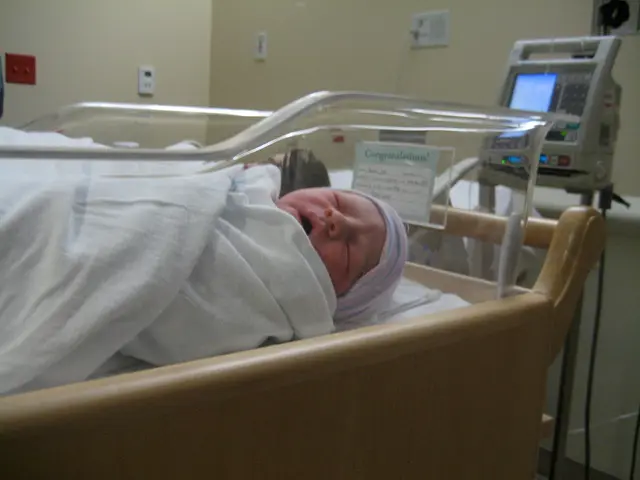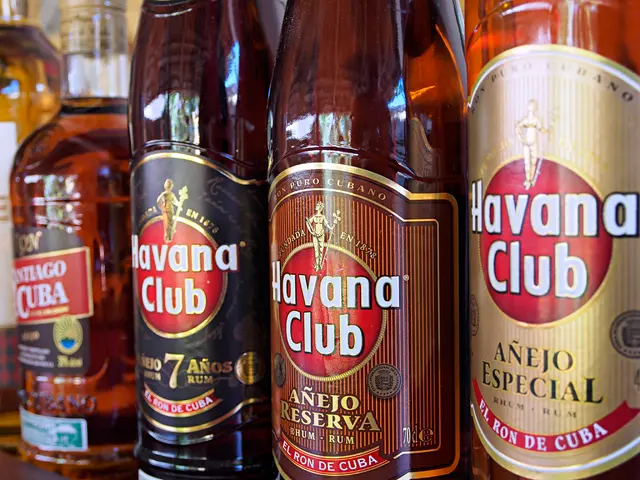Three-person IVF method employs genetic material from three individuals to prevent offspring from inheriting genetic illnesses, yet this practice is prohibited in the United States.
In a remarkable scientific advancement, eight children have been born in the UK, all free from genetic diseases, thanks to a novel three-person IVF technique. This breakthrough, which has been meticulously developed over several decades, is set to open up new avenues of investigation in the medical community.
The procedure, known as mitochondrial replacement therapy, prevents the transfer of mutated genes from inside the mother's mitochondria. In this process, a small amount of healthy mitochondrial DNA from an egg donor is combined with the mother's egg and the father's sperm, reducing the risk of passing on genetic diseases linked to mitochondrial DNA defects.
This technique has been controversial, particularly in the United States, where it is not yet approved. The Food and Drug Administration (FDA) has not yet given its nod to this method, and the debate about its potential approval continues. In contrast, the UK approved mitochondrial replacement therapy in 2015, making it the first country to do so.
The UK's regulatory framework permits the use of donor mitochondria, constituting a very small percentage (about 0.1%) of the child's DNA. This has enabled clinical trials, resulting in the successful birth of several healthy babies using this method.
The process involves several steps. The donor egg begins to divide and develop with its healthy mitochondria, while the mother's egg and the father's sperm provide the nuclear DNA. In cases where all the eggs' mitochondrial DNA carries mutations, the new technique involves fertilizing the mother's egg with the father's sperm, followed by removing the fertilized egg's pronuclei to make room for the mother's egg and father's sperm nuclei.
The donated fertilized egg's pronuclei are then removed, and pieces from inside the mother's fertilized egg and the father's sperm are transferred into the healthy egg provided by an anonymous donor. This results in the replacement of the faulty mitochondrial DNA with healthy mitochondrial DNA from the donor.
Blood levels of mtDNA mutations were significantly lower in all newborns compared to their mothers' levels, indicating the success of the procedure. Mutations in mitochondrial DNA can affect multiple organs, particularly those that require high energy like the brain, liver, heart, muscles, and kidneys.
All eight children have made normal developmental progress, and one is currently pregnant. There have been no miscarriages reported. The researchers' "treasure trove of data" from this study is likely to be the starting point of new avenues of investigation.
Despite the promising results, ethical considerations surrounding three-person IVF remain a topic of discussion. The potential for genetic modification and the creation of "designer babies" are concerns that need to be addressed as this technology continues to evolve.
[1] FDA. (n.d.). Mitochondrial Replacement Therapy. Retrieved from https://www.fda.gov/advice-center/drugs/reproductive-health-drugs/mitochondrial-replacement-therapy [2] Human Fertilisation and Embryology Authority. (2021). Mitochondrial donation. Retrieved from https://www.hfea.gov.uk/treatments/mitochondrial-donation/ [3] Wellcome Trust. (2021). Mitochondrial donation. Retrieved from https://www.wellcome.ac.uk/projects/mitochondrial-donation
- This groundbreaking scientific advancement in the UK has brought eight genetically disease-free children into the world.
- The three-person IVF technique, known as mitochondrial replacement therapy, is a product of decades-long scientific effort.
- The therapy prevents the transfer of mutated genes from the mother's mitochondria, reducing the risk of passing on genetic diseases linked to mitochondrial DNA defects.
- In the United States, the FDA has yet to approve this method, with the debate about its potential approval ongoing.
- In contrast, the UK approved mitochondrial replacement therapy in 2015, making it the first country to do so.
- The UK's regulatory framework allows for the use of donor mitochondria, which constitutes a very small percentage of a child's DNA.
- Clinical trials using this method have resulted in several healthy babies being born.
- The process involves dividing and developing a donor egg with healthy mitochondria, while the mother's egg and the father's sperm provide the nuclear DNA.
- In certain cases, the new technique involves fertilizing the mother's egg with the father's sperm, followed by removing the fertilized egg's pronuclei to make room for the mother's egg and father's sperm nuclei.
- The donated fertilized egg's pronuclei are then removed, and pieces from inside the mother's fertilized egg and the father's sperm are transferred into the healthy egg provided by an anonymous donor.
- This results in the replacement of the faulty mitochondrial DNA with healthy mitochondrial DNA from the donor.
- Blood levels of mtDNA mutations were significantly lower in all newborns compared to their mothers' levels, indicating the success of the procedure.
- Mutations in mitochondrial DNA can affect multiple organs, including the brain, liver, heart, muscles, and kidneys.
- All eight children have made normal developmental progress, and one is currently pregnant, with no miscarriages reported.
- The researchers' "treasure trove of data" from this study is likely to be the starting point of new avenues of investigation in the medical community.
- Despite the promising results, ethical considerations surrounding three-person IVF remain a topic of discussion, including potential genetic modification and the creation of "designer babies."
- FDA, Human Fertilisation and Embryology Authority, and Wellcome Trust websites contain more information about mitochondrial replacement therapy.
- This breakthrough in the world of health and wellness could lead to significant advancements in the treatment of chronic kidney disease, COPD, type-2 diabetes, cancer, and other chronic diseases.
- With improved health and wellness, focus can be shifted towards promoting workplace-wellness, ensuring a healthier and more productive workforce.
- Good health is crucial for maintaining and managing medical conditions such as digestive health, eye health, hearing, and skin care.
- As we explore and expand our knowledge in medical conditions, it's essential to also delve into areas like mental health, men's health, and women's health, addressing issues like Alzheimer's disease, autoimmune disorders, multiple sclerosis, migraine, and breast cancer. Additionally, we must also focus on neurological disorders, environmental science, and environmental health effects, including climate change. Moreover, weight management, sexual health, aging, parenting, and even efficiency in therapies and treatments like medicare and CBD are crucial aspects of health and wellness that require further investigation. Finally, we must not overlook the importance of nutrition, fitness, and exercise to maintain overall health, as well as the impact of factors such as stress and sleep on our well-being.




